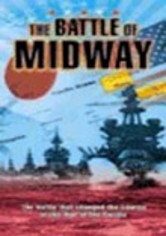
The battle that changed the course of the War in the Pacific
June 1942-By any ordinary standard, the United States Navy was hopelessly outclassed. They had no battleships, the enemy eleven. They had eight cruisers, the enemy twenty- three. They had three carriers (one of them crippled), the enemy had eight...they knew little of war. On one of the carriers, none of the Navy pilots had ever seen combat, nor had any of the Army fliers. Of the Marines, 17 of 21 new pilots were just out of flight school -some with less than four hours of flying time. They were plagued with equipment problems. Some of their dive bombers couldn't dive - the fabric came off the wings. Their torpedoes were slow and unreliable; the torpedo planes even worse. They were up against the finest fighting plane in the world: the Japanese Zero...Yet, they prevailed!
The Americans took crushing losses-15 shot down out of 15 in one torpedo squadron...21 out of 27 in a group of fighters. They had no hope or reason to win. Yet they did, and in doing so they changed the course of the war. Midway showed that every once in a while "what must be" need not be at all. This is the story of strategy, pluck, individual skill and incredible luck, over might.
The Battle of Midway was the most important battle of the war in the Pacific during World War II. Not only was it a demoralizing disaster for the Japanese Navy and the War Commanders, but it deprived the Japanese of their important strategic resource that was essential in the naval battles of the Pacific War-aircraft carriers.
To set the stage for the unparalleled victory, and defeat, the story begins with the conditions in Japan, the U.S., and the world that led up to Pearl Harbor. Why was the U.S. so unprepared, and what were the events that compelled isolationist, imperialist Japan to pursue its aggressive course of Pacific dominance?
Through interviews with some of the men on both sides who fought at sea and in the air the viewer will learn about their contributions to the battle, and the effect it had on their lives. Japanese and American archival footage from the actual battle is featured. Fly with WWII era war planes during dog fights and bombing runs. As the story unfolds, computer graphics illustrate the placement and route that each combatant followed, and the decisive turn of events as ships were attacked and sunk.
The Americans knew the Japanese were coming, they broke the secret code by piecing together 100r 150f an occasional intercept. By scrupulously fitting together hundreds of tiny facts, supported by intuitive logic and good luck, they caught the overly confident army unaware. In the end it was the courage and aggressive attitude of the pilots, sailors and marines that won the day over a superior force of well trained, combat seasoned, and extremely brave Japanese fighters.
Screen
Standard 1.33:1 Color Standard 1.33:1 B&W
Subtitles
None
Audio
ENGLISH: Dolby Digital Stereo
Rating
NR
Average of
ratings: